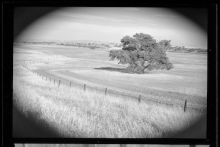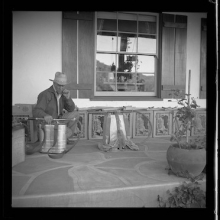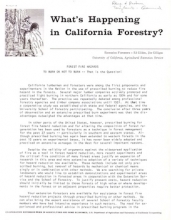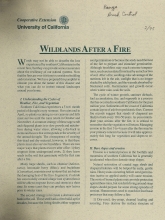A lot has happened since our last blog post in December of 2019. The CARA project team continues to process and digitize archival materials from Merced, Ventura, Humboldt, Fresno, San Joaquin, Santa Barbara, and San Luis Obispo county offices, providing the public with increased access to documents, manuscripts, photographs, and other objects dating back to the beginning of the twentieth century (refer to our previous blog post for information on how to access UCCE archival materials).
There have also been personnel transitions in recent months and as the latest addition to the team, I’d like to introduce myself. My name is Rebecca Gourevitch and I am the new Project Archivist for the California Agricultural Resources Archive. I arrived at UC Merced from Rochester, NY where I earned a MA degree in Photographic Preservation and Collections Management earlier this year. However, California is my home. I grew up in the Bay Area and attended UC Santa Cruz, receiving a BA in Sociology and a MA in Social Documentation. After a couple of years away, it is great to be back in the state I love and I look forward to getting to know UC Merced, the Central Valley, and of course, the fascinating materials found in the UC Cooperative Extension county collections.
I’m happy to join forces with our Digitization Coordinator, Jonathan Wilcox. Jonathan earned his BA from CSU, Dominguez Hills in Art History and received his Master’s in Library and Information Science from San Jose State University. He arrived at UC Merced following an internship position with Curatorial Assistance, Inc. in Pasadena. Since starting in October of last year, Jonathan has overseen the complete physical scanning of the Fresno county collection (approximately 20,000 scans) and of photographic prints of San Joaquin, Ventura, and Humboldt counties. He also oversees our CARA digitization student assistants who, under his guidance, have scanned 627 Humboldt county files, 900 San Joaquin county files, and 200 photographs from Ventura county.
Of course, the shutdowns that began in March, due to the devastating Covid-19 pandemic, have altered (at least for now) the way we do our work. It has been interesting, to say the least, to start a new position in the middle of a global pandemic. The University Library is currently closed to the public and the majority of its staff are working from home. Student assistants can’t access the scanning equipment and trips around the state to inventory more collections are on hold. Despite these challenges, the CARA team continues to work remotely. We have been reviewing the metadata for each of our digitized objects. Metadata is defined as a “characterization or description documenting the identification, management, nature, use, or location of information resources (data). By corroborating these bits of evidence, we make sure that there are various access points by which researchers can discover materials through our online platforms.
Since the pandemic sent our staff and students assistants home, three of our student assistants have either graduated from UC Merced or are continuing their studies at another university. We would like to congratulate Giovanni Alvarado, Maryam Bonyadi, and Amanda Paulino on their achievements and thank them for all of their hard work and dedication to the project. Reflecting on his work with CARA, Gio describes how his experience will aid him in the future:
During my time working with the [Digital Curation & Scholarship] unit, I have gained valuable and useful skills. It is crucial for student employees to follow procedures and be vigilant of any errors that they may come across. Because we work with material that is used for research purposes, it is important for us to do the best possible job. Over the course of two years, I was introduced to new equipment that I was expected to learn how to use in order to complete tasks. Initially, I had trouble getting the hang of how to properly use the equipment and it wasn’t after a couple of weeks until I was able to feel comfortable. Going through this challenge gave me the ability to ask questions whenever I needed clarification, and this will be helpful for when I possibly go to graduate school. My challenging experience has taught me to stay motivated, while also continuing to strive to get better at things that I am having trouble with. This will be very helpful when transitioning over to a graduate program. – Giovanni Alvarado
This work would not be possible without our incredible student assistants and we are lucky to still have so many dedicated students working on the project.
As we move forward this year, the current California wildfires spawn new anxieties and as well as tragedy for too many. They demonstrate the fragility of our environment and the ongoing impact of climate change. They are also a reminder of the value that archival materials hold for understanding how researchers, farmers, scientists, and others have measured the effect of wildfires and communicated fire prevention to the public. The archive contains materials related to California wildfires. In the Santa Barbara and San Luis Obispo Counties, UC Cooperative Extension Records, there are photographic examples of firefighting methods, information about controlled burns, and a document dedicated to the dealing with the aftermath of a destructive fire.
Its introduction states,
Words may not be able to describe the loss experienced by southern Californians in the recent fires, but they can provide some reassurance about the resiliency of our natural systems. Now that the fires are over it is time to consider rebuilding and restoration. We have prepared this pamphlet to educate you about the nature of this disaster and what you can do to restore natural landscapes around your home.
Click on the titles below to view other CARA materials pertaining to California wildfires:

Fire break around an oak tree, undated

Man with a Smith Indian fire pump, undated

What's happening in California forestry? 1963

As we adjust to the challenges this year has brought, the CARA project team has adapted and continues to work with the materials from Extension offices around the state. Look out for future posts to see what we’re up to in the coming weeks and months.

